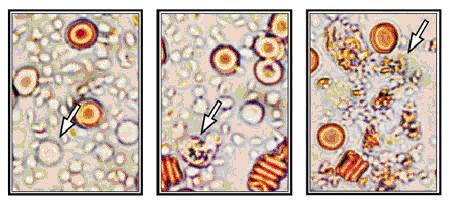Blood Cells Reacting
White Blood Cells Reacting

The picture on the left is taken through a microscope and shows how a healthy white blood cell looks during the Prime Test.® There was no delayed type of allergic reaction when this person’s white blood cells were combined with a minute amount of peas. Thus peas are compatible with this person’s immune system. The orange circles with a dark centers are red blood cells, and the numerous small items are platelets.
The picture in the center shows a person’s white blood cell during a delayed allergic reaction to corn. This cell at the tip of the arrow has blistered and died. When this happens in the body, digestive juices from the white blood cell’s stomachs are released into the bloodstream, causing inflammation throughout the body. This can cause a wide range of physical and mental symptoms.
The picture on the right shows what is left after a severe reaction to corn. All of this person’s white blood cells on the test slide are dead.
Red Blood Cells Reacting

The picture on the left, taken through a microscope, shows how red blood cells should look. They are side-by-side, not stuck together, and free-floating in the liquid part of the blood. They can easily fold in half. The red blood cells are seven microns in diameter while the inside diameter of the small capillaries is four microns. The red blood cells are designed to fold in half so they can flow through the capillaries and deliver oxygen and nutrients to all the body’s cells. When the red blood cells leave the capillaries, they take with them carbon dioxide and other metabolic waist products.
The picture on the right shows what often happens to red blood cells during a delayed allergic reaction or when the amount of vegetable oil or animal fat in a meal is too high. The red blood cells stick together, which keeps them from folding in half, and this blocks their flow through the capillaries. This reaction causes many serious health problems.



